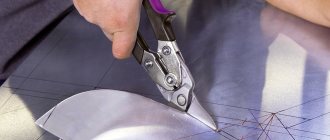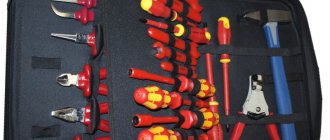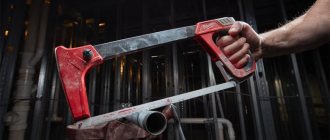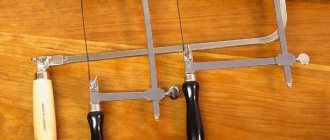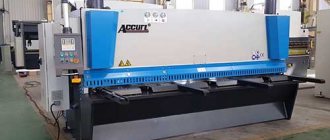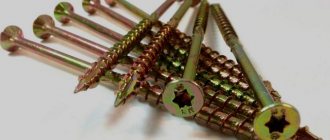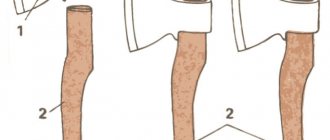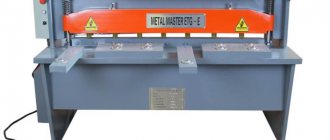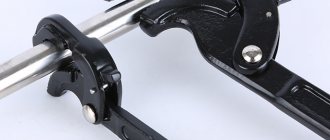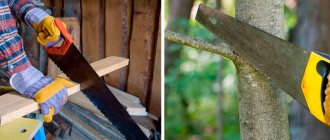What are metal scissors
From the name it becomes clear for what purposes the devices in question are intended. Like regular scissors, metal cutting devices are designed only for working with sheet materials. It is impossible to cut pipes, angles and profiles with metal cutting devices, since they are not designed for this, and simply will not cope with this task.
Structurally, hand-held metal scissors consist of handles and cutting knives. The mobility of the knives is ensured by the mounting bracket. The sharpening angle of cutting knives is 60-75 degrees. This sharpening angle ensures high performance with minimal effort. The large sharpening angle means that the tool can be used for cutting hard metal sheets. The knives in relation to the handle are located at an angle of 7 to 12 degrees.
The knives of the tools in question are made of alloy (chrome-vanadium) or tool steel, which has a positive effect not only on the quality of the cut, but also on the service life. When the blades on knives become dull, they can be sharpened. The tool handles are covered with plastic, rubber or silicone material for ease of work.
This is interesting!
Many people use hand-held metal shears to cut thin sheet metal, such as galvanized sheets or corrugated sheets, and do not know that there are different types of such tools. Depending on the task at hand, it is necessary to select the appropriate type of tool.
Manufacturers of professional scissors
If you are seriously thinking about buying professional scissors, then you should pay attention to the following manufacturers.
N.W.S.
This German company was born in 1973, after the collapse of Walter Gott, the largest manufacturer of hand tools in Europe. NWS did not miss the chance and occupied the market in Germany and neighboring countries with enviable speed. As for products, this company produces both inexpensive and luxury tools. If you look at their products in online stores, metal scissors from this manufacturer will cost you 3,000 rubles.
Bessey
A company with a long history, founded in 1886 in the town of Bietigheim, in southern Germany. At first, the interests of this company were in the field of metalworking. In 1936, it expanded the scope of its activities, starting the production of hand tools, with primacy given to clamping tools. Bessey clamps have become very popular among welders and installers in many countries because of their reliability and quality. Today this company produces more than a thousand types of tools, among them you will find professional metal scissors.
JTC
It specializes in the production of tools for car maintenance and repair, ranging from clamps to professional pneumatic equipment. In 2013, a JTC representative office was opened in Russia. At the moment, all factories of this company are located in Taiwan, so if you see a tool marked made in China, be sure that it is a fake and not a branded tool.
Gasoline motor pump. Water has no chance!
Graphite brushes. Power tool life element
Types of tools
Before you buy hand scissors for cutting thin sheet material, you need to understand their types. To carry out the relevant work on processing sheet steel, you need to take the appropriate tool, which will allow you to achieve the necessary results. What are the devices in question or their types, we will find out further.
- A straight cutting tool is the simplest type of device, which is designed for cutting large circles and straight cutting of material
- Mechanical with curved blades - used for cutting holes, as well as for obtaining cuts of different shapes
- Finger blades with thin blades - used to produce cuts of various shapes. The blades on finger scissors have different positions relative to each other. It follows that tools are divided into left and right, and depending on the task at hand, it is necessary to use the appropriate type of device
- Chair saws - used for cutting thick sheet steel. They cope with steel thicknesses up to 2-3 mm. When cutting thick sheet steel, effort must be made, so the design of the devices has a special bend. This bend is necessary in order to hook the tool to the workbench, thereby ensuring that the upper handle is pressed with high force, increasing the cutting force
- Power - another type of device for cutting sheet metal with a thickness of 2.5 mm. Power mechanical scissors consist of two levers, which are fixed using a hinged bracket. Power tool models come with replaceable discs and blades that can be used to cut metal rods up to 8 mm thick
- Lever scissors are professional models of scissors that are attached to a workbench. The design of such devices is such that one blade is movable and the other is fixed. The movable blade is driven by a handle on the tool. They are used for cutting aluminum, steel, copper, brass, etc. The maximum thickness of steel reaches 4 mm, and brass, copper and aluminum up to 8 mm
All types of scissors are divided into professional and amateur. They differ not only in price, but also in quality. Professional models are made from high-quality materials, so they are intended for constant use. They have a long service life and are 2 times cheaper than amateur ones. Amateur ones are intended for infrequent use, since low-grade types of steel are used for their manufacture.
The best hydraulic shears
Hydraulic shears are equipped with a rod inside that is driven by oil pressure. A blade is attached to the end of the piston. The response side is stationary. The working part is made in the form of a C-shape or with long parallel knives. The operator pumps up the pressure manually by operating the handles.
KVT BRG-12
Rating: 4.9
A tool in this category is specific and is useful only under certain conditions, so we have singled out only one model from a Russian manufacturer in the ranking of the best. Hydraulic shears produce a force of 5 tons, so they can easily cut rebar, square or rod with a diameter of 12 mm. To do this, they have an inflating handle and a cylinder with a piston. The entire body is metal (except for the second handle), which reduces the likelihood of damage if dropped. To quickly relieve pressure, there is a valve with labeled arrows. It is convenient to transport the scissors from site to site in the plastic case included in the kit.
The experts in the reviews like that the product is not subject to mandatory certification according to technical regulations (an official letter from the manufacturer on the sellers’ website), so its use is not limited in any way at facilities subject to state control. And our experts liked the product because it is easy to cut reinforcement with a cross-section of up to 12 mm, which is practical when tying armored belts during construction work. This will not require stringing power lines to the top of the building, and hydraulics will protect your hands from overwork.
Advantages
- valve for quick pressure release;
- durable body;
- cutting force 5 tons;
- practical transport case.
Flaws
- uncomfortable handle;
- the work proceeds slowly (pressure needs to be pumped up);
- The hand gets tired faster from the weight of 2.3 kg.
Manual models of metal scissors and their manufacture
The manufacturing process of hand scissors involves the use of two options:
- Forging
- Casting
Models differ in price. Forged devices are much more expensive than cast ones, but they are much more reliable and durable. To make the blade durable, it is subjected to additional heat treatment. Hardening the cutting part prevents dulling of the cutting part, so it is extremely rare to sharpen this type of tool. After sharpening, the blades will dull much faster.
Cast scissors are suitable for farming, they are inexpensive and do an excellent job. With frequent use of scissors, the blade quickly becomes dull, so they need periodic sharpening. This tool can only cut thin sheet steel up to 2 mm.
This is interesting!
The hinge mechanism on hand scissors consists of two parts, which is done specifically to double the applied physical force.
Manufacturers also produce lever products that are made from two different materials. The cutting part is made of high-quality material, which increases their service life. The handles of such devices are made of ordinary steel, which has a positive effect on the cost of the tool. Using lever shears allows you to cut metal without much effort.
When purchasing hand scissors, you need to consider the placement of the knives. They are straight, as well as left and right. Straight ones are designed for smooth cutting, as well as cutting out large round shapes. As for the left and right shapes of the blades, here you need to know the following:
- Left - used to make cuts in the left direction. The left scissors should be used primarily while holding them in the right hand. When working with a tool with left-handed blades, the left side of the blades enters from below
- Right - used when it is necessary to bend to the right side. When working, you should hold such a tool in your left hand. When cutting with scissors, the right side goes under the sheet from below, which allows you to make an even cut
To make it easier to distinguish them, manufacturers paint the handles in different colors. The right scissors are painted green, and the left scissors are painted red. When using hand-held cutting devices, everyone has encountered the fact that when cutting a long sheet, the plane becomes bent and bent. This usually happens when using scissors with a symmetrical arrangement of knives. To prevent creases from forming, when cutting a long sheet of steel, you need to use a tool with asymmetrical knives.
This is interesting!
Instruments with asymmetrical knives are extremely rare on sale.
The reason for such low popularity is their high cost. However, in order to make an even and neat cut, it is recommended to buy just such metal scissors with asymmetrical blades. What can be cut with hand metal scissors:
- Galvanized steel
- Corrugated sheet
- Metal tiles
- Sheet metal
- Steel mesh
- Linoleum
- Rubber
- Ruberoid
The advantage of hand-held metal shears is that they cost 10 times less than power tools.
Types of scissors for working with metal
Cutting sheet metal is not an easy task. However, scissors designed for this type of event allow contours to be made in various configurations.
To get the desired result, you need to make the right choice. The markets have a wide range of these tools, so before you give preference to one or another model, you should familiarize yourself with their direct purpose and technical characteristics.
Manual
This version of the scissors is designed for working with the following types of metal:
- steel having a diameter from 0.5 mm to 0.7 mm;
- roofing iron;
- metal tiles;
- non-ferrous metals, the thickness of which does not exceed 1.5 mm.
The product includes two short knives and two long handles, as well as an axle, screw and rivet that act as connecting elements. The cutting action of the tool occurs by closing the handles and, accordingly, the knives. The length of such a model can vary from two hundred to four hundred millimeters. Hand scissors can be either right-handed or left-handed, the first version cuts clockwise, the latter - vice versa.
According to the manufacturing method, metal scissors are divided into:
- forged;
- cast;
- composite - lever.
Forged products are high-quality tools; their strengths lie in the increased strength and wear resistance of the blade; their weaknesses lie in their high cost. Cast scissors are inferior to their forged counterparts in the qualities mentioned above. Composite lever models are more convenient than the first two options, this is due to the presence of a lever mechanism and a return spring.
Lever
These scissors are designed for processing sheet metal up to four millimeters thick, as well as corners, wire and rods. The model includes two flat-shaped knives, which are connected using a screw or axle. The lower cutting blade is attached to some workplace and remains motionless, and a handle is attached to the movable upper blade for comfortable work. To fix the material being cut, profile holes of different sizes are often made in the knife blades.
Currently, manufacturers offer an improved type of tabletop lever scissors, equipped with an adjustable stop that facilitates correct cutting and a lever. The lower knife has a sharpening angle of ninety degrees. The blade located at the top has a configuration characterized by convexity and curvilinearity. The movement of this canvas is carried out under the influence of a lever. During the cutting process, the material being processed is located on the lower knife, and the marking line is under the upper blade.
Guillotine
A similar device is used in large manufacturing enterprises, in workshops for processing material whose thickness reaches thirty-two millimeters, and for strip rolling. Guillotine shears operate on the same principle as lever shears, but in comparison they have the following differences:
- the presence of an electrical or hydraulic wire at the blade located at the top;
- big sizes.
One type of guillotine model is represented by hydraulic shears, designed for cutting metal sheets, cutting reinforcement, all kinds of cables and making holes in workpieces.
Machine
Manual models for cutting metal are not characterized by high productivity, for this reason they are used in single production. When carrying out mass work, the best option is to use mechanized (machine) shears. These products operate thanks to an electric drive.
Nibblers
Such scissors are called nibblers; they are quite common and represent a miniature press. They are usually used when working with profiled metal or corrugated pipes. The principle of operation of such tools is to displace material anywhere. Products can be equipped with additional blades for making holes. Nibblers allow both right-handed and left-handed placement of the cutting element.
This option is intended for work with small volumes. Its advantage lies in the convenient performance of figured cutting and processing of material in the transverse direction. Since nibblers are designed for cutting profiled metal, their weakness is the formation of curvature at the edge of the craft during the cutting process; this defect must be straightened upon completion of the work.
Roller
The purpose of this tool is to cut workpieces made of different metals. Their design is quite simple and their performance is high, making them ideal for use in workshops and manufacturing plants. The thickness of the material processed by roller shears should be up to one millimeter. The tool is most often used in the construction of fences and working with roofing materials.
The advantages of this product are its low weight, simple settings, and ease of use. Roller shears are distinguished by correct cutting, eliminating the formation of burrs and curvature. The design includes a power section and a pair of disc roller cutters capable of rotating in different directions, thereby pressing into the workpiece and cutting it. The cutting edges of the device are located in the same plane; after cutting, there is no need to clean the edge.
Electrical
Most versions of electric scissors resemble a grinder in appearance. Certain models fit comfortably in the hand due to the special shape of the body: narrow and elongated. Most tools are equipped with remote handles, which makes them easier to handle during operation.
For the manufacture of the body of these designs, ABS plastic is used, which is impact-resistant. In addition, electric scissors differ from each other in the design of the mechanism, due to the operation of which the material is processed.
According to the principle of operation, all electric models are divided into the following types:
- leafy;
- perforated (cut-out);
- splined.
Compared to hand scissors, such equipment has a number of advantages:
- automatic process;
- high quality and accuracy of work;
- ability to cut material with a thickness of 3 mm;
- high performance;
- no deformation of metal sheets during processing;
- ease of use, eliminating injuries and cuts.
Electric scissors for fast and precise cutting of sheet material
Accuracy and accuracy of cutting with hand scissors is ensured only by choosing the right tool. In addition to manual scissors, manufacturers also produce electric scissors. The power tool does not require any physical effort to cut sheet material, since the electric motor is responsible for this action. There are two types of electric metal shears:
- Punching or die-cutting - structurally they have no resemblance to manual ones
- Knife - similar to hand tools, and their work is ensured by the mobility of one blade
Die-cut
received this name due to their operating principle. They are used for cutting sheets of corrugated sheets and metal tiles. The advantage of such devices is their ease of use and operational efficiency. When cutting through a steel sheet, sparks do not occur, and the roof covering does not deform. That is why it is recommended to abandon the use of an angle grinder when cutting thin-sheet material, replacing it with manual or electric scissors, or even better, buy an attachment for a drill for cutting metal.
Electric cutting scissors can not only cut straight, but also cut out various curly patterns. If you plan to cut a shape in the center of the sheet, then first you need to drill a hole and then install the cutting edge of the scissors into it. They work on the principle of a hole punch, and a movable mechanism—a punch—is responsible for punching through steel. When piercing steel, the knife moves very quickly, so the possibility of deformation and bending of the sheet is excluded.
In addition to cutting (or mortise) scissors, there are also knife scissors
. They are also called sheet or spline. They are very similar to manual ones, only they consist of movable and stationary knives. The movable blade moves due to an electric drive, making reciprocating movements. They are suitable not only for making straight cuts, but also for curved ones.
During operation, such scissors do not create waste, but they have a drawback - they jam the corrugated sheets. It is recommended to use them exclusively for cutting smooth sheet materials such as galvanized sheets, tin, etc. During operation, only the movable cutting knife becomes dull, which must be sharpened and replaced when worn.
Sheet shears have one fixed blade and the other a movable one. Slotted ones differ from them in that they have two fixed knives at the bottom and one movable one at the top. When using spline tools, chips are formed, the size of which does not exceed a few millimeters. The shavings are rounded when working with scissors and go to the side. You can work with a spline tool not only on the smooth surface of sheet materials, but also on corrugated sheets and metal tiles.
Bosch GSC 75-16
Main characteristics:
- Tool type - sheet (cut);
- Power - 750 W;
- The number of strokes at idle speed is 5200 strokes/min;
- Minimum cutting radius - 35 mm;
- Weight - 1.7 kg.
Type of scissors and design. These corded sheet metal shears are equipped with a 750W electric motor to ensure high performance. The upper and lower knives are square-shaped with four cutting edges that can be easily deployed if they lose their sharpness.
Functionality and purpose. The tool is designed for straight and shaped cutting of steel sheets up to 1.6 mm thick with a material strength of no more than 400 n/mm. The stroke rate under load reaches 4000 movements per minute. The minimum turning radius of 35 mm is not inferior in maneuverability to most analogues.
Figure cutting Bosch GSC 75-16.
Ease of use. This model weighs 1.7 kg. It has an elongated plastic body that can be held with one or two hands. A special plate protects the brush from possible damage. The start key has two fixed positions, which is convenient for long-term work.
Pros of Bosch GSC 75-16
- High cutting speed.
- High quality build.
- Availability of service repairs and ease of replacement of knives.
- Reliability.
- Ease of management.
- No waste.
- Low vibration level.
Cons of Bosch GSC 75-16
- High price.
- Poor view of the cutting area.
Why do you need guillotine shears?
There is another type of scissors, which also belongs to the group of hand tools. They're called
guillotine, which consist of a frame, as well as a fixed knife and a movable blade. Due to their design, they are also called tabletop or stationary. To cut sheet material, it is necessary to place the sheet on the knife according to preliminary markings. The sheet is cut by lowering the cutting blade.
This type of tool is suitable exclusively for cutting in a straight direction. They are not suitable for circular cutting, so you should choose a tool depending on its purpose. Guillotine shears are used in industry when large volumes of work are performed. Manufacturers also produce hydraulic guillotine tools for cutting pipes, profiles and other compact non-sheet materials.
Compliance with safety rules when working with tools
When cutting, you should always wear special construction glasses. They will protect your eyes and the area around them from possible small chips.
Also, when carrying out such work, it is necessary to wear cotton gloves to prevent the tool from slipping out of your hands. During the cutting process itself, it is strongly recommended not to place your hands or feet nearby, as an awkward movement can cause serious injury to the cutter.
Each of the types of cutting tools discussed in the article is designed for specific tasks. When choosing, you should always pay attention to the characteristics of such equipment. When working, always follow the established rules and safety precautions to protect yourself and anyone nearby from possible injury.
How to choose scissors for cutting metal
Choosing a tool is the most important undertaking, since the purchase determines the ability not only to do the job, but also to do it efficiently. Every craftsman should have a pair of metal scissors in his arsenal. The prices for these devices vary, so you should choose depending on the tasks at hand. If you need to cut reinforcement, it is better to choose hydraulic guillotine shears, and for cutting galvanized sheets, ordinary ones with straight blades are suitable.
Which scissors to choose for the job depends on the technological tasks, so you need to focus on the following parameters:
- The location of the blades is left and right. Depends on what types of cuts you plan to make
- The shape of the blades is straight and curved. Scissors with straight blades are convenient for cutting in a straight direction, and curved blades can be used to make curved and shaped cuts.
- The capabilities of the tool depend on the material from which the device is made. They are cast, forged, and mixed
This is interesting!
Often, a decrease in the performance of scissors occurs not due to dulling of the blades, but due to a violation of the distance between the knives. The distance increases due to the loosening of the hinge joint under heavy loads. To improve the quality of metal cutting, the tool must be periodically adjusted.
Working with hand scissors is not difficult if you choose them correctly for certain jobs. Once you try a power tool in action, you probably won’t want to go back to hand tools. The only advantage of manual devices is that they are not expensive, so it is worth buying them so that you can use them at any time to cut thin-sheet materials. The video below explains in detail how to use the tool in question correctly.
To summarize, it should be noted that the devices in question are manufactured according to the relevant standards GOST 7210-75. To choose the best scissors, you don’t need to look for a rating of the best, since price is an indicator of quality. However, if you do not choose the right tool for the appropriate type of work, then even high quality and high price will not help.
What to look for when choosing
When deciding on the choice of scissors for cutting metal, you need to know what kind of alloy is used and what its thickness will be. Not all handmade products can handle thick sheets.
It is necessary to decide on the tasks at hand, whether regular cutting or shaped cutting is required. If you need an electric tool, then you should pay attention to its power and the type of cutters. Most of the models presented have replaceable cutters.
This allows you to select scissors for a specific type of metal. The last thing to consider when choosing a product is its power. Electric motors also vary in number of revolutions. The more complex the cutting, the higher the power required.
